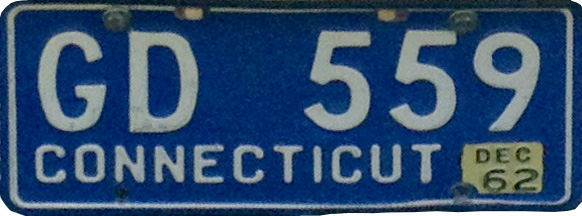Emissions inspections are required every two years. The state notifies registered vehicle owners of an upcoming test date 45 days in advance of when the test is due to be conducted.
Diesel Vehicles:
Diesel vehicles are required to be tested in the same manner as gasoline powered vehicles
Exemptions:
- 2017, 2018, 2019, 2020 model year vehicles;
- Model year 1995 and older vehicles;
- Vehicles with a gross vehicle weight rating of 10,001 pounds or more;
- Composite Vehicles (vehicle must be titled as a composite vehicle);
- Full electric-powered (non-hybrid);
- Bicycles with motors attached;
- Motorcycles;
- Certain vehicles registered but not designed primarily for highway use;
- Farm vehicles;
- Vehicles with Dealer, Repairer, or Transporter Plates
For more information visit: http://ctemissions.com/
Connecticut General Statutes
Sec. 14-80. Mechanical equipment.
(a) Each motor vehicle and the devices on such vehicle shall be operated, equipped, constructed and adjusted to prevent unnecessary or unusual noise.
(b) Each motor vehicle operated by an internal combustion engine shall be equipped, except as hereinafter provided, with a muffler or mufflers designed to prevent excessive, unusual or unnecessary exhaust noise. The muffler or mufflers shall be maintained by the owner in good working order and shall be in use whenever the motor vehicle is operated. No person, including a motor vehicle dealer or repairer or a motorcycle dealer, shall install, and no person shall use, on a motor vehicle, a muffler or mufflers lacking interior baffle plates or other effective muffling devices, a gutted muffler, a muffler cutout or a straight exhaust except when the motor vehicle is operated in a race, contest or demonstration of speed or skill as a public exhibition pursuant to subsection (a) of section 14-164a, or any mechanical device which will amplify the noise emitted by the vehicle. No person, including a motor vehicle dealer or repairer or a motorcycle dealer, shall remove all or part of any muffler on a motor vehicle except to repair or replace the muffler or part for the more effective prevention of noise. No person shall use on the exhaust system or tail pipe of a motor vehicle any extension or device which will cause excessive or unusual noise.
(c) The engine of every motor vehicle shall be equipped and adjusted to prevent excessive fumes or exhaust smoke.
(d) All pipes carrying exhaust gases from the motor shall be constructed of, and maintained with, leak-proof metal. Exhaust pipes shall be directed from the muffler or mufflers toward the rear of the vehicle and shall be approximately parallel with the longitudinal axis of the vehicle and approximately parallel to the surface of the roadway, or shall be directed from the muffler upward to a location above the cab or body of the vehicle so that fumes, gases and smoke are directed away from the occupants of the vehicle. Exhaust pipes on a passenger vehicle shall extend to the extreme rear end of the vehicle's body, not including the bumper and its attachments to the body, or shall be attached to the vehicle in such a way that the exhaust pipes direct the exhaust gases to either side of the vehicle ensuring that fresh ambient air is located under the vehicle at all times. The Commissioner of Motor Vehicles may adopt regulations in accordance with the provisions of chapter 54 to establish safety standards for passenger vehicles equipped with exhaust pipes located in front of the rear axle.
(g) Any person who violates any provision of this section shall be fined one hundred fifty dollars for each offense.
Regs. Conn. State Agencies
Sec. 14-80a-4a. Allowable noise levels
Motor vehicle and snowmobile noise emissions when measured with the sound level measuring microphone located 50 feet (15.2 m) from the target point in accordance with the requirements of section 14-80a-7a shall not exceed the following specified values:
(a) Any motor vehicle or combination motor vehicle having a G.V.W.R. or G.C.W.R. of less than 10,000 pounds (4536 kg) including passenger motor vehicles:
Maximum Permissible Sound Level Readings dB(A)
Vehicles Manufactured:
Prior to Jan. 1, 1979: SOFT SITE: Highway Speed Limit 35 MPH or less – 76 dB(A). Highway Speed Limit above 35 MPH – 82 dB(A). HARD SITE: Highway Speed Limit 35 MPH or less – 78 dB(A). Highway Speed Limit above 35 MPH – 84 dB(A).
On and after Jan. 1, 1979: SOFT SITE: Highway Speed Limit 35 MPH or less – 72 dB(A). Highway Speed Limit above 35 MPH – 79 dB(A). HARD SITE: Highway Speed Limit 35 MPH or less – 74 dB(A). Highway Speed Limit above 35 MPH – 81 dB(A).

Classic Vehicle
Available for vehicles that are at least 20 years old and currently registered in Connecticut. The Classic Vehicle plates replace the Early American (Antique) license plates. Fee for replacing "Early American" style plate with "Classic Vehicle" plate: $27. Fee to get classic vehicle plate for the first time: $47 fee plus 2-year registration fee (Varies depending on amount of time left on current registration. You will be credited with the amount of time left on current registration.)

YOM
Available for antique, rare, or special interest vehicles that are currently registered with “Early American” or “Classic Vehicle” plates with DMV approval. "Early American" or "Classic" plates, registration documents, and the Application to Display Year of Original Manufacture Plates (form B-320) must be carried within the vehicle at all times. No fee.
